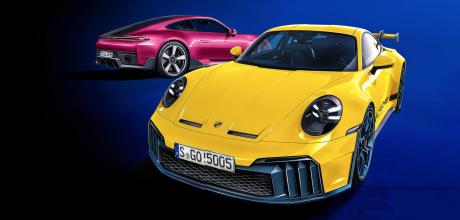The next 2026 Porsche 911 994
This is it: everything we know of the 911’s next decade – two generations, some big numbers and a very hot hybrid, all before the proposed 2032 switch to electric…
Words Georg Kacher
Illustrations LARSONdesign
How Porsche will make the most of the 911’s final six-cylinder years
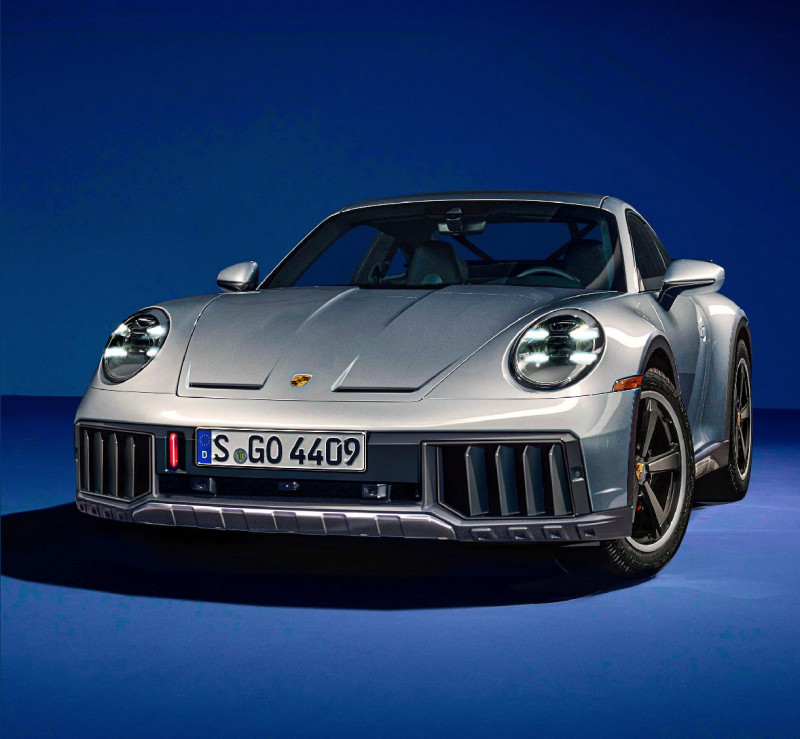
Try to see it in rational terms. The key – and we appreciate it’s not easy when it comes to matters 911 – is to try to avoid getting too emotional. Accentuate the positives. Count your blessings. Because, yes, the 911 will – according to the current plan – go electric early in the next decade. But between now and then (and let’s face it, 2013 feels like a lifetime ago…) we have a feast of hybrid and naturally-aspirated 911s to look forward to.
The extensively facelifted 992, the 992.2, arrives early next year. As ever, this generation will run to an array of body styles and powertrains, including bigger-displacement hybridised boxer engines. But if that idea gets you panicking, don’t: the high-revving, naturally-aspirated GT3 models are safe through 2028. But there’s change on the GT front, too – the flagship GT2 RS (last seen back in 2018, when its mix of race-bred chassis and savage turbo power was bested only by Ferrari’s transcendental 488 Pista in our Sports Car Giant Test) is set to become the marque’s first hybridised flagship supercar since the 918 Spyder.
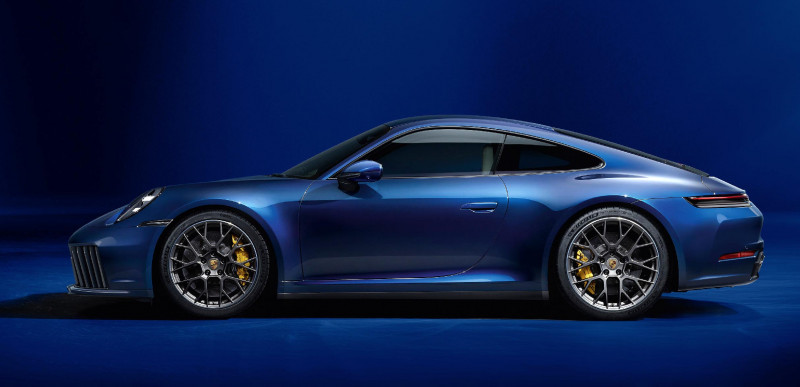
Happy so far? The all-new, next-generation 994 is set to arrive in 2028, and it could well be the last new 911 into which you’ll pump petrol. Its all-electric, 998-generation successor is pencilled in (these days no one has the luxury of working in ink, even Porsche…) for 2032. And far from apologetically limping over the finish line, tail between its rear wheels, the combustion-engined 911’s sunset years will involve a dramatic increase in production volumes – adding up to 15,000 units a year, starting this autumn.
WORKING ON SOLID STATE BATTERIES WITH QUANTUMSCAPE
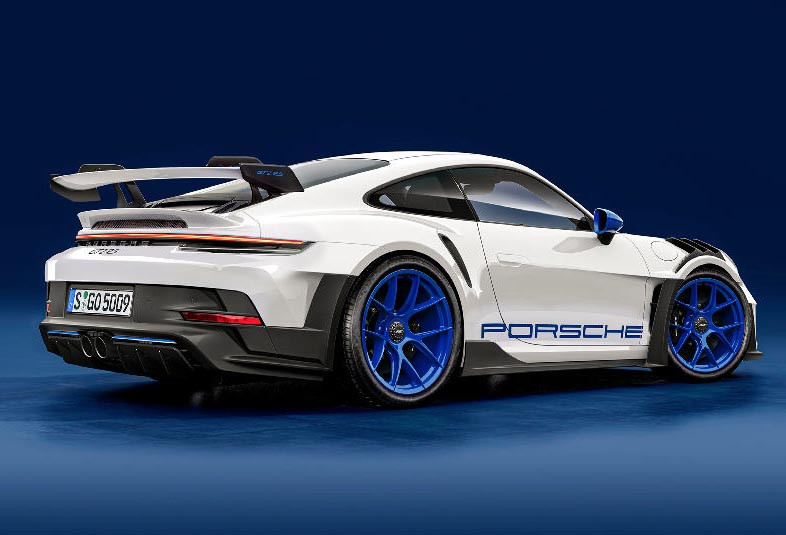
More so than ever, the 911 is Porsche’s main brand shaper and its most profitable product. After all, the evergreen sports car – currently in its eighth generation – epitomises the marque’s strongest virtues: iconic design, breakthrough engineering, best-in-class performance, unique driving and ownership experience, and exceptional build quality. It’s a winning formula not to be messed with, which is why the all-electric 911, originally due in September 2028, was put on the backburner against the will of the since-departed VW Group CEO Herbert Diess. Instead, Porsche is now in a parallel move investing millions in the production and distribution of CO2- neutral eFuels (see panel, page 65) that could help protect its future rear-engined sports cars. At the same time, eFuels should help to keep the huge fleet of current and historic 911s street-legal way into the next decade. Meanwhile, another round of flat-six fireworks should keep the 992.2 and its replacement ahead of the game.
‘WHY NOT A THIRD PI LLAR, AFTER OUR HERITAGE MODELS AND SPORTY GT CARS? WHY NOT OFF-ROAD, TOO? ’ CEO OL IVER B LUME
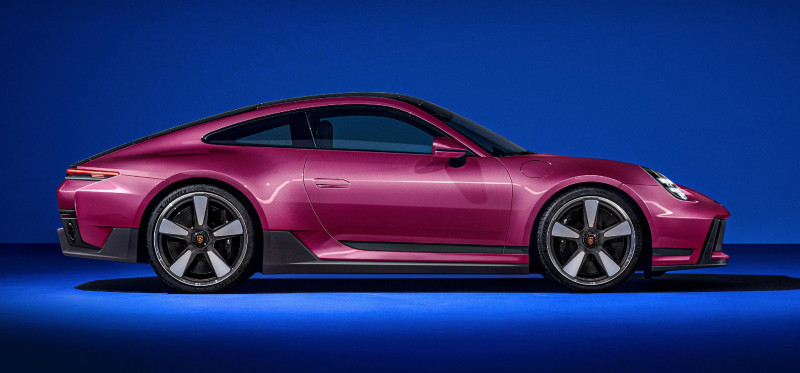
The biggest challenge for project 992.2 – to be presented late this year, before deliveries start next February – is to prepare the engine line-up for the upcoming EU7 emissions regulations. The need to meet the repeatedly tweaked legislation while simultaneously maintaining or even increasing power output and torque entails a number of different actions, including a bigger displacement, more potent turbochargers and multitier hybridisation.
Also in the works is Porsche’s first outright performance hybrid powertrain (an e-boosted twin-turbo six) since the 918’s, which should power the range-topping GT2 RS due in 2026 at the latest, two years before the 992.2 bites the dust. In an interview with Bloomberg, CEO Oliver Blume confirmed the debut of the new high-performance model, which is a hybrid but not a plug-in (the correspondingly smaller battery helps keep weight, a modern 911 bugbear, down). Instead, the brawniest-ever roadgoing 911 rated at a still unconfirmed 750bhp or so (the briefly available peak output is claimed to be even higher) will almost certainly share key tech elements with the 963 LMDh endurance racer.
The standardised LMDh hybrid system uses a Bosch e-motor and a 50kWh lithium-ion battery. Energy regeneration is restricted to 200kW. Apparently, Porsche back in 2021 filed a patent which details a clever new approach to super-efficient air cooling of future high-performance hybrid engines. According to patent number 20220162983, the battery is positioned close to the intake ducts, where the nearby electric turbochargers add cooling duties to their familiar forced-induction tasks. Apparently, this complex but compact intercooled bypass layout is dramatically lighter than any type of liquid cooling circuit or a brace of equally potent but power-sapping highspeed fans – a solution that was evaluated but rejected.
A 10.8KWH 48-VOLT MI LD HYBRID FLAT-SIX WI LL ENTER PRODUCTION IN 2024
We also hear that Mate Rimac of Bugatti fame is participating in the development of powertrain systems and componentry, which includes new batteries allegedly provided by Cellforce, a German joint venture by Porsche and Customcells. Thanks to this innovative bi-directional thermo-management concept, the energy pack is kept within the ideal 30ºC to 70ºC operating bracket at all times. Furthermore, Rimac is believed to be a senior consultant on battery management, performance electronics, and e-motor and inverter design. The surprisingly small battery stack positioned under the rear seat is connected to a bespoke 382-volt system, not the 800-volt power pack chosen for the Taycan. The weight penalty incurred by the hybrid hardware is said to be in the area of 100kg.
From a buyer’s perspective, one of the key benefits of the 992.2 is increased production capacity – up from the current 40,000 a year. This means that from November onwards delivery times are set to come down, particularly for more affordable 911s. Think the Carreras, the basic cabriolets and the odd manual-transmission coupe. During the past two years, these lower-margin models were squeezed out by big money makers like the Turbo, the GT3 twins and anything with a limited-edition sticker. This availability squeeze did push up resale values, but it hit less well-heeled customers with fast-growing waiting lists and price increases.
By shifting the Boxster and Cayman twins out of the overcrowded Zuffenhausen parent factory to the underused Karmann plant in Osnabrück, Porsche can boost the 911 output by about 30 per cent. Long-term, intra-factory production flexibility will be reintroduced with the fully electric 983 two-seater, out in 2025.
As far as the design of the 992.2 is concerned, our illustrations show what our inside information tells us: the sheet metal goes largely untouched, but all the soft parts will be modified to denote the mid-cycle model change. With the 992 Michael Mauer and his exterior chief designer Peter Varga did a fine job cleaning up the front and rear by reducing the number of ungainly black plastic inserts, freshening the four-dot matrix headlights and honing the aerodynamic performance Inside, the last remaining analogue instrument – the prominent tacho – is about to be replaced by a fully integrated digital item. While they were at it, the ergonomists have also improved the legibility of the hi-res gauges and dials, cleaned up the centre stack and introduced the latest Porsche cockpit tech; check out the 2024 model-year Cayenne for reference. Since the 994 is still very much a petrol-engined sports car, we expect the ninth-generation 911 to avoid a hard visual break with tradition. If that comes at all, it will likely be reserved for the electric 998. The position of the engine remains unchanged, as do the cooling requirements, the essential weight distribution and the 2+2 layout. Within this familiar framework, however, there will be fresh ideas.
The Dakar package could, for instance, be offered in combination with less powerful engines and optionally without the fake-sponsored liveries. As CEO Blume told CAR: ‘Why not a third pillar, after the sporty GT and our heritage models? Why not off-road, too? We will see how the market success of the Dakar pans out. And then maybe there will be more to come. The door is now open.’
The Targa may reappear in less luxurious and more emotional form, the overdue Speedster is bound to stage a highly profitable comeback, the lightweight Clubsport package could replace the half-hearted T, and there is talk of a widebody option for the GTS. Also believed to be in the running are a fixed-head coupe based on the Turbo Cabrio, the next high-end RS and ST versions, a roofless single-seat Spyder with micro windscreen and an 850bhp GT2 street racer.
We understand a 10.8kWh 48-volt mild-hybrid application courtesy of Valeo will enter production in 2024. This programme will however likely bypass the GT3 models, equipped as they are with the trad seven-speed PDK1 gearbox that is about 50kg lighter than the much more common triple-shift eight-speeder PDK2. While PDK2 can package virtually any kind of hybrid module, PDK1 does not. According to one independent analyst, hybridisation and software tweaks will together yield a two-stage power and torque boost by 133bhp and 117lb ft, then 195bhp with 173lb ft.
When the 994 arrives in 2028, the GT models are expected to be phased out in favour of high-rev, twin-turbo boxers. But the hardcore and riotously popular GT cars should in 992.2 form remain faithful to the charismatic naturally-aspirated 4.0-litre flat-six all the way to the end.
Not too long ago, Porsche was hoping that an increase in displacement from 3.0 to 3.4 litres would more than compensate for all the mandatory pending clean-air actions, But it now seems 3.6 litres is a safer bet.
Dubbed 9A3 Evo, the new mainstay powerplant is expected to develop 400bhp and 347lb ft in the two- and four-wheel-drive Carreras (up from 380bhp and 332lb ft), 454bhp and 406lb ft in the best-selling Carrera S cars (up from 444bhp and 391lb ft), and circa 483bhp and 413lb ft in the Carrera GTSs (up from 473bhp, but with peak torque down from 420lb ft). Currently rated at 503bhp and 518bhp, we expect the output of the more thoroughly de-smogged GT3 units to increase only very slightly to around 508bhp for the GT/touring and 520- 525bhp for the GT3 RS. Last but not least, there are the Turbo and the Turbo S, both of which should feature the latest 9A3 flat-six engine. The Weissach grapevine is suggesting 612bhp and 583lb ft for the Turbo (up from 572bhp and 553lb ft) and 680bhp and 598lb ft (up from 641bhp and 590lb ft) for the hard-charging S.
Looking even deeper into the crystal ball, we can decipher the still sketchy outlines of the fully electric 998. For this car, Porsche is believed to be considering radical steer-by-wire and brake-by-wire concepts. While sounding faintly sacrilegious, this approach would save weight and, by replacing conventional steering and braking elements with multi-directional, multimode torque-vectoring algorithms, would yield significant new packaging and dynamics opportunities Too extreme for a down-to-earth driving machine like the 911? Time will tell. Another element currently peddled by the rumour mill revolves around the breakthrough solid state batteries Porsche is reportedly developing for this lineup together with QuantumScape, a California-based affiliate of the Volkswagen Group. The ultra-fast-charging 918-volt system pays homage to the brand’s most recent supercar, though almost certainly unintentionally…
As mentioned earlier, it seems certain than a fully electric 911 would also choose a more progressive design route. There’s simply too much risk attached to abandoning the coveted cornerstones of its long-running visual DNA. Last year, there was talk of a Vision 60 concept conceived to celebrate the best-seller’s 60th birthday in 2023, but although the one-off showpiece is still under wraps as this issue goes to press, a designer characterised its trend-setting shape as ‘sexy, cool, extreme and radically modern. Wide and low, it is beautifully sculpted and muscular.’
If this description is anything like the true to the shape of things to come, 911 fans have nothing to worry about.
If big visual changes are coming, they won’t be with 2028’s 994
Where the recent 992 Dakar forged a path, off-road-ready 992.2 911s will follow
Brace yourself for an expanded off-road offering with future 911s


